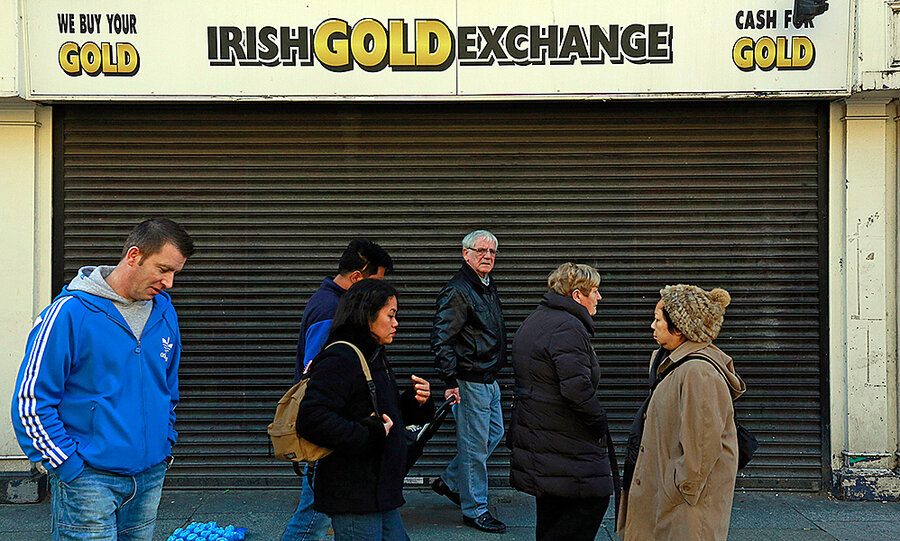A new great Irish emigration, this time of the educated
Loading...
| Dublin, Ireland
During Ireland’s two-decade economic boom, the so-called Celtic Tiger, young people were referred to as "tiger cubs."
Now, amid Ireland's sixth year of financial crisis following the 2008 economic crash, you don't hear the term much any more.
Since 2008, 400,000 people have left Irish shores, from a population of just over 4.5 million. Almost 250 leave the country every day, prompting many to ask if Ireland has returned to old habits. Is the Emerald Isle once again exporting its population?
Immigrating from a growing Ireland
Ireland’s recession – the prime mover of the population shift – is something of a paradox.
Walk the streets of the capital city Dublin and the busy shops, pubs, and restaurants look much the same as they did during the fat years. But outlying towns, even ones relatively close to the city, tell a different story, with shops boarded up and local sports organizations struggling to field teams. Almost 100,000 mortgages are underwater, yet widespread foreclosures have not yet occurred.
The story with emigration is no less contradictory. Despite the mass emigration, Ireland’s population continues to grow. According to recent figures from the government’s Central Statistics Office (CSO), the Irish population grew by 7,700 between April 2012 and 2013. Ireland has experienced the third largest population increase in the European Union since 2002.
New births and continued inward migration, primarily from central and eastern Europe, explain the anomaly. In the same period, births outstripped deaths by more than double: 70,500 versus 29,700. Some 89,000 people left Ireland, while 55,000 arrived. For the first time since 1987, there are now more than a million people under 14.
Some recent arrivals to Ireland are leaving, but the CSO says “net outward migration [of Irish citizens] is estimated to have increased significantly” while “that of non-Irish nationals is estimated to have changed from net outward to net inward.”
Brain drain
Unlike previous rounds of mass emigration from Ireland – in the nineteenth century, the 1950s, and the 1980s – those leaving are not indigent and unskilled. This is not a tale of coffin ships crossing the Atlantic or horny-handed laborers shipping out to London or Liverpool. Today’s migrants are as often as not college graduates: architects, engineers, designers, and other young professionals.
Alan Barrett, head of economic analysis at the Economic and Social Research Institute think tank, says that “a lot of the out-migration is of the most skilled and most able.” He adds that the population outflow is large, both by international and Irish historical standards.
“It’s a back-to-the-future situation. It’s very, very significant and the age distribution is interesting. We discovered of people aged 50 and over, five percent of their kids had emigrated. The average age was 28,” he says.
Top destinations are Britain, Canada, New Zealand, and Australia, but America remains a perennial favorite with some 20,000 Irish arriving between April 2012 and 2013. Official US immigration figures note 1,171 Irish people with "extraordinary abilities or achievements" as well as 1,259 athletes, artists, and entertainers being awarded green cards, hinting at a potential brain drain.
A study performed by University College Cork (UCC), published last September, found that rural areas have been disproportionately affected and that those leaving are more likely to have a university qualification than the general population.
The loss of skilled workers is already troubling employers but IBEC, the Irish Business and Employers Confederation, says difficulties finding qualified employees are limited to certain sectors.
“There are specific skill shortages in niche areas, such as [information and communications technology], where there’s been a global demand, and high-end manufacturing, particularly around bio-pharma and medical devices“, says Tony Donohoe, head of education policy at IBEC.
Will they come back?
Mr. Donohoe says he expects Irish migration patterns to return to normal soon enough. “We’ve seen 58,000 jobs created here in the last year, so we expect to see the migration flow stop. The people who left in the 1980s and came back in the 1990s drove the Celtic Tiger.”
But economist Constantin Gurdgiev paints a gloomier picture. “We are facing a classic brain drain,” he says. Even jobs in the coveted multinational sector offer little opportunity for career progression, he says.
“This basically means that selection biases are working to incentivize exits not by only more skilled or better educated, but also by those who have higher aptitude towards work, who are willing to invest in their careers over the life cycle, rather than just to settle for a token job.”
The feeling among young people is similarly grim. A protest movement of students and recent graduates called We’re Not Leaving has been holding demonstrations and public meetings, and the National Youth Council of Ireland (NYCI), which represents Irish youth organizations, has expressed concern at the emigration rate.
NYCI research also indicates that today’s emigrants may not become the backbone of any future economic recovery: “82 percent of those we surveyed wanted to return, but only 22 percent thought it was likely,” says senior researcher Marie-Claire McAleer. “We can’t take return emigration for granted.”








